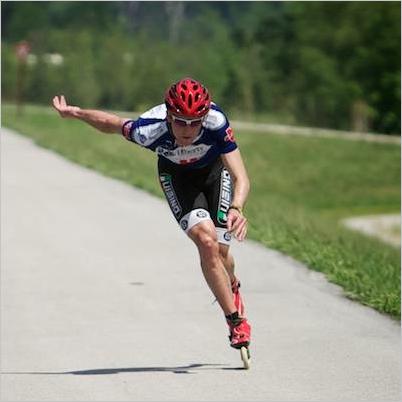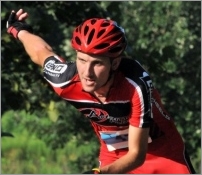This week's tip:
It's All About the Push
How to get more power by pushing into the skating surface
By Ty Fidler

Ty Fidler on inlines
Photo: Ty Fidler
Over the last two winters, I’ve spent a lot of time on ice. And it’s been great. It’s helped me polish my inline technique and enhanced my knowledge of skating in general.
The number one thing I’ve learned — and the thing I hear over and over again from elite ice skaters and coaches — is to "put pressure into the ice."
At first, I wasn’t sure what this meant. I thought that pushing hard — in other words, consciously applying pressure to the skating surface — was a waste of energy.
The secret of speed, I thought, was moving your legs fast and going as hard as you could. But I was wrong. Eventually, I realized that applying pressure to the skating surface is the key to speed. And if you think about it, it makes sense.
In skating, we generate forward momentum by pushing to the side. So it follows that how fast we go depends in part on how hard we push.
Once I understood this, I started focusing on learning to maximize the pressure I apply to the skating surface.
Now when I skate I always remember the words of my coach in Milwaukee, Bon Fenn: “Push down through the ice.”
This gives me a mental image of what my push should feel like.
When I’m on inlines, I amend Fenn's mantra to “push down through the pavement” and concentrate on pushing down rather than out to the side or to the back.
The result for me has been more speed and power. But of course, pushing into the pavement is just part of the story. Here are some to keep in mind to add power to your push:
1) Get low.
It’s the piston action of your legs, bending and extending, that powers your push. So you've got to have lots of knee bend. That means training yourself to skate in a low position with your knees bent and your butt low.
2) Land over your skate.
After your D-recovery loop, land your skate a few inches ahead of your support foot. And make sure your body weight is directly over your skate when it touches down. If it's not, your push won't have the force of your body behind it. (One of the best ways to learn to land your skate properly is to practice the Line Drill described in this Skate Tip by Patrick Creveling.)
3) Control your arm swing.
Swing your arms in a relaxed but controlled manner. If you swing them too high or too far to the side, your body will pull away from the direction of travel. And that will slow you down. Focus on driving your arms forward and keeping your backswing at or below your waist.
4) Be still in motion.
Keep your upper body perfectly still and your shoulders parallel to the ground. Any bouncing, bobbing or twisting pulls your body away from the direction of travel, wasting energy.
5) Keep your hips rock solid.
Same thing goes for your hips. Don't let them move up or down or to the side. As with upper body motion, this saps power. One thing that helps is to bend your ankles forward (along with knees, of course). This helps to keep your hips low so your legs can do their job with out any extra motion.
6) Don’t rush your push.
You've got to be patient and relaxed to skate well. Wait until you are ready to land your skate before you set your wheels down. If you land your skate early — before you are ready to transfer your weight to it — your push will lack power.
All these things improve your push. And that makes them well worth the effort. The more I learn about skating, the more I realize it is all about the push.
...
 Ty Fidler is a speed skater based in St. Louis, MO. He began his racing career in 2010, finishing second in the pro open division of the National Roller Cup. In 2011, he was a member of the winning team at the Montreal Roller 24-Hour Marathon and finished second at the Apostle Islands Inline Marathon. He's also had multiple Top 10 finishes at major outdoor events, including the Chicagoland Inline Marathon and the New York 100K. In 2012, he will be a member of Pinnacle Racing's Marathon Team.
Ty Fidler is a speed skater based in St. Louis, MO. He began his racing career in 2010, finishing second in the pro open division of the National Roller Cup. In 2011, he was a member of the winning team at the Montreal Roller 24-Hour Marathon and finished second at the Apostle Islands Inline Marathon. He's also had multiple Top 10 finishes at major outdoor events, including the Chicagoland Inline Marathon and the New York 100K. In 2012, he will be a member of Pinnacle Racing's Marathon Team.